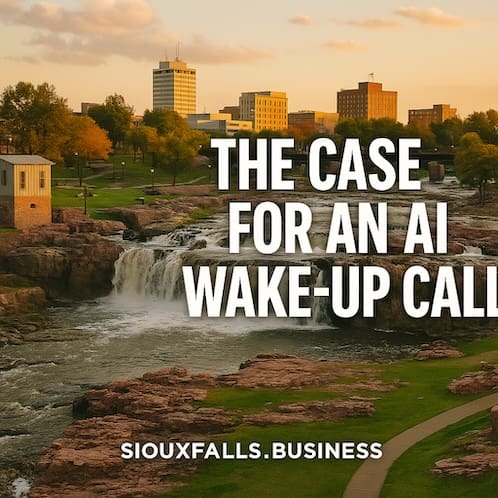Sept. 7, 2025
I knew the headline for this week’s column — but had no idea what image to put with it.
I had a hunch what could solve my problem, though.
“I am writing a column for SiouxFalls.Business about AI and the need for Sioux Falls businesses to learn to use it,” I typed into ChatGPT.
“The headline is ‘The case for an AI wake-up call.’ I’m not sure what to use as an image. Could you create one that blends both Sioux Falls and this headline?”
This was the first attempt.
It wasn’t what I wanted, though, and it was my fault for not being precise enough in my prompt.
“I should note, I don’t actually want the words used in the image. I want the image to reflect the words,” I typed back. “Your image of Sioux Falls is nice. But can you also incorporate the theme of the headline?”
Here was the next version.
“I like it! Good job,” I told it.
“Thank you! I’m glad you like it,” it replied.”Let me know if you’d like alternate versions, different styles (e.g. more abstract, futuristic, or minimalist), or if you need a web- or print-ready file format. Happy to help however you’d like to use it in the column.”
If you’ve started using ChatGPT in your work life, as I have, this won’t surprise you. If not, well, welcome to the wake-up call.
Generative AI, a type of artificial intelligence that can create new, original content, has evolved rapidly this year. If you are not yet starting to incorporate this into your work flow, it’s time to get going or you’re going to find yourself at a competitive disadvantage.
In my own work world, I’ve already found multiple time-saving and content-enhancing applications for AI. The potential to unlock more is enormous and should benefit both our readers and my business. I feel like I need to figure out how to invest more time specifically in figuring this out, because others in my industries are and will.
The other day, I was working on a story that will run in the next couple of weeks about some proposed projects. The renderings were nicely done, and I asked if an architect should be credited. I was told the intern had created them using AI. Welcome to the first of many professions that will be disrupted.
The more obvious application is in writing, where I would caution you that while much of the copy generated by AI might “sound good,” it leans toward generic in some cases and over the top in others. I’m pretty good at figuring out when it’s being used — and there are plenty of detectors that confirm my suspicions. That said, the technology constantly is improving and the more it “learns” your personal communication style, the better it can assist.
This point in time reminds me a bit of the birth of widespread Internet service.
In 1995, hardly any business had a website.
By 2005, all the early adopters had one and most businesses of any scale had one.
By 2010, if you didn’t have one, you were considered behind the times and missing out of business because of it.
Fifteen years to go from new technology to standard. And I think AI adoption by its very nature will go faster — if we can keep up.
About a year ago, the Prairie Family Business Association surveyed 160 regional family businesses about a variety of topics, including for the first time AI.
Thirteen percent of firms had implemented AI into their business practices, and only 18 percent of companies felt they had the necessary skills to do so. When asked whether AI can provide a higher return on investment, 58 percent indicated “neither agree nor disagree.”
Only 11 percent of family businesses agreed that top management promoted AI as a strategic priority, and 17 percent said they agreed that their company has AI skills.
That’s concerning for future sustainability. I understand it’s hard to know where to start or to immediately see applications for your business, but it can be as easy as creating a free account and exploring its capabilities. I’m also definitely starting to see the opportunities for entrepreneurially-minded people and organizations that can become experts in helping others navigate the changing landscape ahead.
At the same point, as a community, we need to recognize the very real threat AI seems to pose to certain segments of the economy. That next recession many of us have been anticipating for years could be driven by job loss in traditional “white-collar” roles eliminated or scaled back because of what AI can do faster, cheaper and more accurately.
I also see a very real threat to human intellect in this. Much as the Industrial Revolution led to people being less physically active, it stands to reason the looming AI revolution could do the same for us mentally. The better AI gets at forming thoughts for us, the less some learn to think, analyze and evaluate for themselves? I could see it. The ones who will succeed will keep pace with the technology and leverage it effectively. Or they will gravitate toward occupations that are more difficult to supplant with automation and AI. Communities should position themselves to do the same.
Remember what ChatGPT asked me about the Sioux Falls image? Would I like to see a more futuristic one? Here it is.
A bit dark or even sinister, don’t you think? But given the context, maybe fitting. That said, I had to ask if it really thought Sioux Falls would see buildings as tall as the ones in the image.
ChatGPT responded with an analysis of current tall buildings in Sioux Falls, a reference to the Downtown 2035 plan, a note that the city was working on its Shape Sioux Falls 2050 comprehensive plan and a conclusion that Sioux Falls “is still poised to evolve with mid-rise, mixed-use developments—likely in the 4–10 story range—rather than transforming into a metropolis of towering skyscrapers.”
The good news for me is that three of the five sources used for this conclusion came from SiouxFalls.Business. At least in media, I appear to add value in providing information deemed credible enough for ChatGPT to use — not like I’m getting paid for it, of course, but that’s another issue.
We will start to do more coverage of AI — the businesses that are using it and the issues that come along with it. I think it needs to be part of our role as a business media organization to help raise awareness of this paradigm-shifting technology. Hopefully the stories will be read — if not as soon as they’re published, then as soon as the inevitable AI wake-up call arrives for you and your business.


